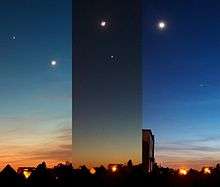Appulse
Appulse is an astronomical term that refers to the shortest apparent distance between one celestial object and another, as seen from a third body during a given period.[1] The term usually refers to the closest apparent approach of two planets together in the sky, or of the Moon to a star or planet while the Moon orbits Earth, as seen from Earth.
An appulse is related to a conjunction, but the definitions differ in detail. While an appulse occurs when the apparent separation between two bodies is at its minimum, a conjunction occurs at the moment when the two bodies have the same right ascension or ecliptic longitude. In general, the precise time of an appulse will be different from that of a conjunction.[2] In some particular cases, it is possible for an appulse to occur without a conjunction.
When the celestial bodies appear so close together that one actually passes in front of the other, the event may be a transit, occultation, or eclipse.
An appulse is an apparent phenomenon caused by perspective only; the two objects involved are not near in physical space. Scientists insist that appulses have no direct effect on the Earth. They can be interesting naked-eye events for general observers when involving bright planets and the Moon. Furthermore, they allow easy finding of faint objects when such objects are involved.
